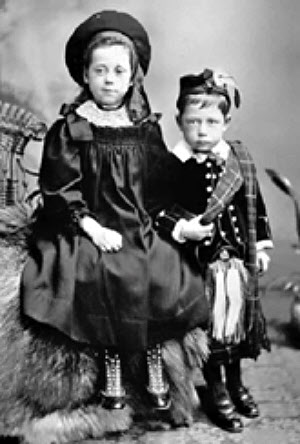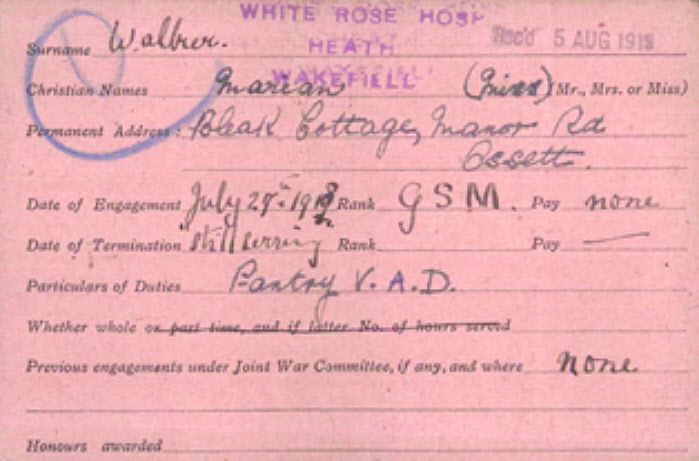
Marian Walker was born in Ossett on the 9th July 1895, the daughter and eldest child of John Walker (born Flushdyke, Ossett in 1867) and his wife Annie Ada (nee Hall), who had married in October 1894 at Christ Church, South Ossett. In 1891, before his marriage, John Walker, who was from Flushdyke, Ossett was working as an insurance agent and living with his parents in Horbury.
By 1901, Marian was living with her parents, 33 year old John Walker and 32 year old Annie Ada together with her brother Clifford Walker (born 1898). Marian is pictured (left) with her younger brother Clifford probably in 1902. Sadly, Clifford Walker was to lose his life towards the end of WW1 when he died on the 5th November 1918 in hospital in Rouen, France from influenza after suffering previously from pneumonia.
By 1911, the Walker family are living on Intake Lane (near Sunnydale) and John Walker is now working as a rag merchant. The Walkers moved to live at Bleak Cottage, Manor Road, Ossett, some time before 1915 when John Walker was a rag merchant with premises in Town End, Ossett.
Marian Walker began working for the Voluntary Aid Detachment (VAD) at the White Rose Hospital, Heath, Wakefield, from the 27th July 1918 when she was 22 years of age.
During WW1 many civilian hospitals were turned over to military use. As the number of injured servicemen rose and the demand for beds grew, large buildings – such as universities, hotels and stately homes – were transformed into hospitals. One such stately home was Heath Hall, Wakefield which, for the duration of the war, was renamed the White Rose Auxiliary Hospital.
Additional nursing staff was needed and this was met by a mixture of qualified nurses and volunteers. VADs had to be between 23 and 38 years old. Women under 23 were rarely registered as nurses with the Red Cross, but the rule was not enforced for women over 38 who had no diminished capacity. Marian was one such volunteer.

Above: Marian Walker’s VAD record card.
It is thought that whilst Marian Walker was working at Heath Hall, she met injured soldier Private Thomas Evans, who served with the Mechanical Transport Section of the Army Supply Corps. It is possible that Thomas Evans knew Marian’s brother Clifford Walker, who also served in the A.S.C.
Marian collected the thoughts, recollections and comments of some of the soldiers recuperating at the hospital with a small autograph book. The collection features little rhymes and snippets of wisdom, for example on soldier wrote: “distance parts, but does not sever, a friend remains a friend for ever.”
There are also sketches of soldiers , family, regiment badges and humorous cartoons, made in pencil and ink. One of the pages has a love poem dedicated to Marian entitled “Thoughts of You” by Private Thomas Evans.1
On New Year’s Day, 1921 Marian married 22 year-old colliery fitter Thomas Evans from Wigan, Lancashire at the Wesleyan Church, Wesley Street, Ossett. By 1939, the Evans family were living at 70, Manor Road, Ossett and Thomas Evans was now working for Ossett Corporation as a sewage worker. There were three children to their marriage: Vera, born in 1922; Walter, born in 1924 and Derek born in 1927.

Above: Wedding banns from Marian Walker’s wedding to Thomas Evans on the 1st January 1921.
Marian Evans died on the 13th March 1974 in the Scunthorpe area.
The Red Cross and The Order of St John of Jerusalem organised voluntary aid detachments (VADs), made up of men and women, in every county to carry out transport duties and staff rest stations and hospitals. By October 1910, 202 detachments had been registered with over 6,000 volunteers. Membership of the detachments grew still further on the outbreak of the First World War when the Joint War Committee was formed.
Auxiliary Hospitals, established and operated under the auspices of The Red Cross which had secured buildings, equipment and staff. Thus the organisation was able to set up temporary hospitals as soon as wounded men began to arrive from abroad. The buildings varied widely, ranging from town halls and schools to large and small private houses, both in the country and in cities. The most suitable ones were established as auxiliary hospitals. There were over 3,000 auxiliary hospitals administered by Red Cross county directors.

Above: Heath Hall in 1907, later to become the White Rose Auxiliary Hospital during WW1. The hospital was the convalescent home for up to 100 soldiers who had been injured during the war.
In many cases, women in the local neighbourhood volunteered on a part-time basis. The hospitals often needed to supplement voluntary work with paid roles, such as cooks. Local medics also volunteered, despite the extra strain that the medical profession was already under at that time. The patients at these hospitals were generally less seriously wounded than at other hospitals and they needed to convalesce. The servicemen preferred the auxiliary hospitals to military hospitals because they were not so strict, they were less crowded and the surroundings were more homely.
At an early stage of the war women began to be invited to serve in a range of capacities, of which nursing was one. Thousands of young women from middle-class homes with little experience of domestic work, not much relevant education and total ignorance of male bodies, volunteered and found themselves pitched into hospital environments. Those women who joined the VAD could be trained, in cookery, sanitation, bandaging and dressings, washing of bodies and linens, and proper procedure before, during, and after surgeries. To become a VAD Member, a woman would write to her Country Director for instructions, or to the Secretary of the Joint Women’s VAD Department, which was stationed inside Devonshire House, who would then forward the name of her local County Director.
During WW1, there was the view that V.A.D.s, initially were mostly middle-class women eager to “do their bit,” performed a variety of duties. At home the organisation administered auxiliary hospitals and convalescent homes and much of the V.A.D. service consisted of general nursing duties and administering first aid. Qualified nurses were also employed to work in these establishments. In addition, clerical and kitchen duties were performed by V.A.D.s, and as many men were engaged in military service, female V.A.D.s took on roles such as ambulance drivers, civil defence workers and welfare officers.
References
1. Information courtesy of Louise Bragan, Cultural Officer: Learning and Skills, Wakefield District Council (WMDC)